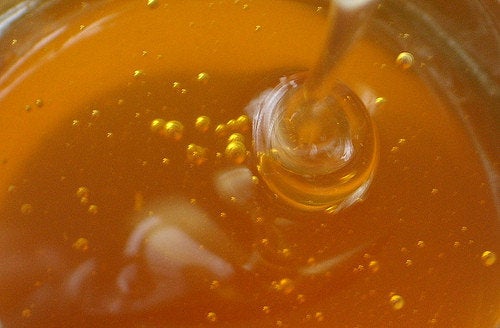
I love foods that are sweet-and-sour, sweet-and-salty, or just plain sweet. From various types of sugar in baked goods to honey in my cranberry sauce and tea, from brown sugar in the topping for my corned beef to a tad of sugar in tomato sauce or my slow-cooked onion appetizer, sweeteners are an important part of my pantry.
At this time of year, sweetness is especially on my mind. Celebrating the Jewish High Holy Days, I've been using the traditional greeting, "Have a sweet New Year" often this past week, eating more than my share of apples and honey, and generally enjoying the sweet desserts common to holiday meals.
It never hurts to have a few facts about what you're eating. In that spirit, here's a quick guide and a few tips about using sweeteners made from natural products. For information on artificial sweeteners, check here.
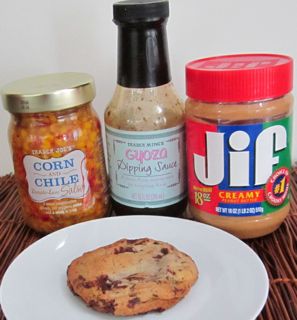
What do these items have in common? They all contain sugar or other sweeteners.
- White sugar -- From beets or sugar cane.
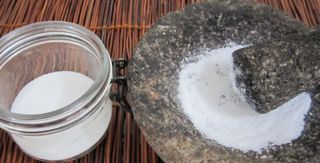
Raw, turbinado or demerara -- Made from the juice of sugar cane, that is put through an evaporation process and the remaining granules are relatively large (coarse) and brown. I use it for my coffee, on top of foamed milk.
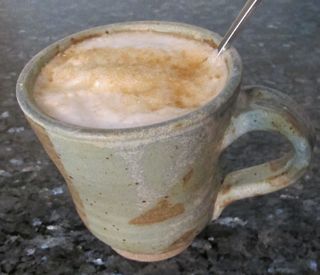
Brown (dark and light) -- Generally made by adding molasses back into white sugar. Dark brown sugar has more molasses (by ratio) than light brown. You can make brown sugar by adding molasses to white sugar, roughly in the ratio of 1-3 teaspoons of molasses per cup of white sugar.
Honey -- Made by bees using nectar from flowers. The color and taste depends on which type(s) of flower(s) the nectar came from. In the U.S. honey is graded based on clarity and other factors. Lighter honeys tend to have lighter (less definitive taste) than the darker ones.
Agave nectar or syrup -- Processed from the agave plant, which is a succulent like cactus.
Stevia -- Processed from the leaves of a plant that is classified as an herb.
Corn syrup
- Corn syrup used at home -- Recipes that call for corn syrup refer to a syrupy mixture of various kinds of sugars from corn. Light corn syrup also contains vanilla and salt. Dark corn syrup also contains molasses, salt, coloring and a preservative.
- High fructose corn syrup -- Made from corn syrup processed to convert some of the glucose into fructose. It is used in beverages and other commercially prepared foods as a substitute for more expensive sweeteners, such as white table sugar made from cane sugar or beets. There is controversy over whether it is less healthy than white sugar, but in any event, it is not healthy to consume large amounts of added sweeteners of any kind.
Molasses -- From the residue of sugar cane, it has a strong taste. Molasses is a component of brown sugar and dark corn syrup.
Maple syrup -- While it's most popular use may be as a topping for french toast, pancakes or waffles, maple syrup is also used as a sweetener, especially in sauces and fruit desserts.
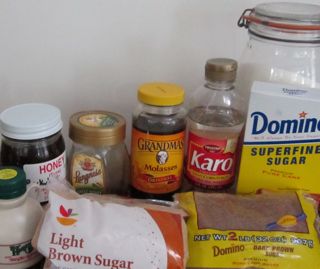
Tips about sweeteners
- Be careful about substituting sweeteners. Although their primary function is to sweeten (duh!), the color, texture and volume of a sweetener affects how food in which it is used looks and tastes. For example, if a cake recipe calls for sugar and you want to use honey, consider how the substitution would affect the consistency and volume of the ingredients, as well as the way they will mix together. You may be able to make the substitution, but you will need to take all those factors into account and experiment with how to best make the substitution. Also, not all sweeteners taste alike. If you don't believe me, try a bit of white sugar and compare it to the taste of dark brown sugar, or compare agave syrup to dark honey.
- Granulated sugar does not dissolve well in cold liquids. If you want to sweeten iced tea, iced coffee or an Arnold Palmer, it's best to add the sugar before icing cools or use superfine sugar. As an alternative, consider using honey. If your honey is thick, you can microwave it on a low setting for a few seconds to make it even more liquid and help it mix more easily.
- Sweeteners have different levels of sweetness. For example, agave is sweeter than white cane or beet sugar (by volume), so a teaspoon of agave tastes sweeter than a teaspoon of white sugar. Stevia is considerably sweeter than white sugar (several hundred times as sweet), while honey is roughly the same sweetness as white sugar.
- Reading labels. If a label says "no added sugar," it means that no additional sugar was added, but the product may still contain naturally occurring sugar or artificial sweeteners such as aspartame, saccharine or sucralose (Splenda). Also, that product may have naturally occurring sugar. For example, many "no added sugar" jams contain fruit juice with naturally occurring sugar.
Much as I love sweet food, I don't like to find sweetener hidden in canned, boxed and prepared food. When you buy canned, boxed, frozen or prepared items at the grocery store, check out the labels. See if sugar, corn syrup or another sweetener is listed as an ingredient in each item, and if so, where it is in the order of ingredients. (Ingredients are listed in the order of their predominance in the food. If it is at or near the head of the list, then the sweetener is a predominant ingredient in the food item.) If you find sweetener in a food where you didn’t expect to find it, I’d love to hear about your discovery. Just click here and send me a note letting me know what you found.